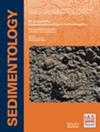Universal decomposition model: An efficient technique for palaeoenvironmental reconstruction from grain‐size distribution
IF 2.8
2区 地球科学
Q1 GEOLOGY
引用次数: 0
Abstract
For many years, researchers have used the decomposition of grain‐size distributions to acquire critical information on provenances, transport dynamics and depositional environments. This study presents a novel decomposition method, termed the universal decomposition model, for analysing grain‐size data. The universal decomposition model unifies single‐sample unmixing and end‐member modelling analysis approaches and overcomes their respective limitations. To evaluate the effectiveness of the universal decomposition model, an artificial dataset and borehole data from the west Weihe Basin were analysed. Results indicate that the universal decomposition model algorithm performs proficiently on both datasets. Correlation analysis was employed to compare the abilities of universal decomposition model, single‐sample unmixing and end‐member modelling analysis to extract minor signals, with universal decomposition model and single‐sample unmixing exhibiting greater proficiency. Furthermore, the universal decomposition model provides a broader perspective for contrasting single‐sample unmixing and end‐member modelling analysis. The study highlights the inadequacy of the statistical method for determining the optimal number of components and summarizes an empirical approach. Moreover, disregarding the potential diversity in component shapes of real‐world sediments has been demonstrated to be a sub‐optimal design. Finally, this article presents results of a new investigation into the geological significance of sediment grain sizes revealed by various analytical methods that suggest that the universal decomposition model has enormous potential in reconstructing paleoenvironment.通用分解模型:一种从粒度分布重建古环境的有效技术
本文章由计算机程序翻译,如有差异,请以英文原文为准。
求助全文
约1分钟内获得全文
求助全文
来源期刊

Sedimentology
地学-地质学
CiteScore
8.20
自引率
11.40%
发文量
94
审稿时长
6-12 weeks
期刊介绍:
The international leader in its field, Sedimentology publishes ground-breaking research from across the spectrum of sedimentology, sedimentary geology and sedimentary geochemistry.
Areas covered include: experimental and theoretical grain transport; sediment fluxes; modern and ancient sedimentary environments; sequence stratigraphy sediment-organism interaction; palaeosoils; diagenesis; stable isotope geochemistry; environmental sedimentology
 求助内容:
求助内容: 应助结果提醒方式:
应助结果提醒方式:


